Use of Chiaroscuro Lighting in Early Cinema
- Light and Shadow
Introduction
An interesting example of lighting techniques in early cinema is the approach
taken to lighting by german expressionist filmmakers that made great use
of chiaroscuro lighting techniques. The German Expressionist filmmakers
were also influenced greatly by the approaches taken to art by the expressionist
art movement that focused on interpreting reality by focusing on the artist
or characters inner emotions and focusing on more turmoil and melancholic
emotions.
Chiaroscuro lighting was also used by photographers, two focused on here who created work in the 1930's approached this kind of lighting in different ways and also very different to the german expressionist approach. Take expressionism out of the equation and there is a totally different result. The first one Laszlo Moholy-Nagy was also a painter, metalwork artist and filmmaker. His approach focused on the lines and planes of light and dark. His subject matter was often his own creation such as reflective metal and glass sculptors pieces that were photographed. He emphasised the patterns created by light and dark. Bill Brandt focused more on depth with his use of chiaroscuro lighting , he defined the three-dimensional aspects of the photo to give depth and clarity to both the fore and background.
Chiaroscuro Lighting
Expressionism
German Expressionist Cinema 1919 - 1923
The Cabinet of Dr. Caligari, Director Robert Wiene, (1919)
Nosferatu, Director F. W. Murnau
Film Noir
Photograper and filmmaker Laszlo Moholy-Nagy
Photographer Bill Brandt
Maya Deren
Blade Runner
CHIAROSCURO LIGHTING
LIGHT AND
DARK- playing around with shadows
The term is generally used to
denote a way of representing a lighting effect using light and shade.
Chiaroscuro (camaieu) was first used in the Italian quattrocento (15th
century) when it replaced the even lighting used in medieval painting. The
word is derived from Italian
The term chiaroscuro (kee-AR-o-SKOOR-o) derives from the Italian chiaro (light) and oscuro (dark). It is the aesthetic approach to distribution and contrast of light and shade in a painting. The skilful use of light and shade (sometimes called values) which creates a three-dimensional effect, either subtle or dramatic, is the quality found in the works of 16th century masters such as Leonardo da Vinci and Raphael, and 17th century masters, Caravaggio and Rembrandt. We can practically apply the same principle in the scene lighting. Light and shadow with chiaroscuro qualities can be implemented at each part of the scene by keeping an eye on the scene planes and by paying a special attention to the light source. The lighting needed to achieve that chiaroscuro effect can be defined as a "directed soft" lighting. Although seemingly contradictory, this phrase which unifies two opposite natures of light actually correctly explains the nature of lighting needed to achieve the chiaroscuro effect - the soft light with a lot of contrast at the same time and soft edged shadows. The simple example for such quality of light would be the interior illuminated with beams of soft overcast day light getting in through a relatively small window.
 The Scream (1893), Edvard Munch
The Scream (1893), Edvard Munch
Expression begins in painting and poetry around 1910. Then seen in literature and next in theatre and then spreads to opera, architecture, and then film
Expressionist art concieved of itself as something of an opposite of Impressionism. While Impressionism sought to give an outward impression of an object, Expressionism wanted to impose the emotional feel an object invokes upon the object itself. An Expressionist painting is more about the artist than the subject. link
...expressionism emphasized a given artist's emotional, intensely personal reactions; it was thus in contrast to the traditional view that an artist should strive faithfully to reproduce the natural appearance of the object or person being painted, sculpted, or written about." All different definitions of "Expressionism" acquaint it as a theory of art that expresses feelings in an abstract way. ...link
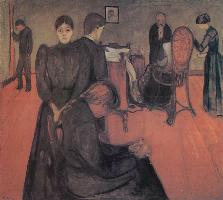 Death in The Sickroom (1893), Edvard Munch
Death in The Sickroom (1893), Edvard Munch
Style distorted to express the artist's inner torment.
Fascination
with death, disease, illness, depression, melancholy, etc. . .
Eerie Atmospheres - Popular Expressionist -
Potray
the inner reality of emotions. Artificial sets and staging. Contemporary
theatre in front of the camera - creating sets that reflected the inner
lives of the characters. Actors acted with exagerated movements, stage
sets with expressive lights and shadow effects, unusual rotations of axis
and extreme camera angles - eerie atmosphere - influenced the horrow
genre
http://www.kyushu-ns.ac.jp/~allan/Documents/CCEurope-04.html
 The Tempest (1914), Oskar Kokoschka
The Tempest (1914), Oskar Kokoschka
Expressionist artists were inspired by ancient myths. They were particularly inspired by German and Nordic mythology, and its tales of gods, devils, witches, magic, spirits, religion and middle ages Christianity. The artists also picked up some aspects of non-European art, to African art, Asian art, and tribal arts for models, images, ideas, and a sense of the supernatural. Expressionism, with the emphasis on emotion, insanity, German and Nordic mythology, was found in the theatre. Expressionist theatre told strong emotional stories, often with elements of alienation and insanity.
 Key features of Expressionism:
Key features of Expressionism:
- Art was to express emotions
- Used wood block prints, influence from pre-15th century German, Gothic art.
- Influenced by the wild, strong, non-realistic colours of Van Gogh, and Rousseau.
- Expressionist artist used strong emotional colours and wild brush strokes.
- The stressed irrationality of the world, the natural and the social world
- The world of the supernatural was a strong influence, of ghosts, magic, monsters, strange things happening, to mythic tales, etc.
- Individual alienation from the natural world and from the social world — The individual does not feel like they belong in either the social world or the natural world. That they are alone and abandoned.
- The impact of industrial, capitalist society on human beings.
The specific influences of Expressionism on films are:
- The influence Expressionist painting can be seen in the way the film set was painted and built.
- There is a strong use of darkness and light, especially of shadow.
- There is also use of strange angles in making Expressionist cinema, strange camera perspectives.
- The story is sometimes taken from Gothic myth, the 14th century, e.g., Caligari, Dracula, ghosts.
- The supernatural has a very strong place in the film.
- There is the appearance of irrationality, in the world, in the people, and in the story.
- Emotions are strongly expressed.
- The film and the world appear to be insane.
- An insane world is not a place where there is a happy ending.
The German Expressionist cinema from 1919 to 1933 was a new movie style that revealed a few widely regarded films. As adapted for film Pam Cook describes expressionism in her Cinema Book as an "extreme stylisation of mise en scene... " and "The stylistic features of German Expressionism are fairly specific and include chiaroscuro lighting , surrealistic settings and, frequently, a remarkable fluidity of mobile framing." Flashback adds that German Expressionism "concentrated on a heavy use of light and dark contrasts, exaggeration, tilted angles, a dream like atmosphere" and "German films of this area are united by their uncanny evocation of stimmung ..." link
A sense of horror
Being the product of a people essentially
displaced within their own country and social order, these films radiate a
sense of displacement, whether it is the madman's twisted reality in
The Cabinet of Dr. Caligari, the foreign menace of
Nosferatu, the young nobleman's journey-of-self and the dehumanized
conflict of owners vs. workers in Metropolis, or the hazy dreaminess of
Vampyr. There is always a fundamental sense of "wrongness" in
Expressionist films that gives them their horror. ... The artistic design
of German Expressionism teeters on the brink of archetype and stereotype.
Common features include a high contrast between light and dark shading,
eccentric (and often highly angular) set designs, dream-like haziness, and
eerie or horrifying characters. The whole process is meant to involve the
viewer in the landscape of the characters' (and by extension the artists')
minds. Expressionist artistic conventions have gone on to influence horror
culture ever since, including ample use in Universal's Son of
Frankenstein, Orson Welles' and Tim Burton's pictures, and the Gothic
subculture. Expressionism also played a huge part in the genesis of Film
Noir. link
• Influenced by theatrical producer Max Reinhardt.
• Huge
architectural sets.
• Careful period costuming.
• Chiaroscuro
lighting.
• Large casts and movement on stage.
Expressionist Cinema Characteristics
• Style distorted to express
the artist's inner torment.
• Fascination with death, disease,
illness, depression, melancholy, etc. . . .
• E.g., The Cabinet of Dr.
Caligari, Robert Wiene, 1919.
Themes include . . .
• The Grotesque
• Counter / Opposition to
Authority
• Abstraction
• Distortion or heightened sense of
reality
• Fantasy
• Psychological landscape vs. external reality
• Horror, dark fantasy, the Gothic
• Illness, death, insanity
Visual Style and Mise-en-scene
• Set design, lighting, costume
design (props), blocking (actor movement).
• Sets express inner state
of characters
• Lighting stylized to express inner states
•
Performance Style/Blocking--jerky gestures express inner torment
link
Marraige between a painting and a stage play
Expressionist artists had already established themselves in the theatre and painting as a reaction to realism. They aimed at portraying the inner reality of emotions. German expressionism owes its success above all to its artificial sets and staging. Set designers created inspired sets that reflected the inner lives of the characters. They came very close to contemporary theatre; created in front of, rather than with the camera. The actors acted with exaggerated movements, which make them seem like stilted gestures today. The stage sets were draped in expressive light and shadow effects, while unusual rotations of axis and extreme camera angles gave them an eerie atmosphere. This artificial style did not last for long, but its influence on the development of the horror and gangster films of the 30’s is undeniable. Link
The Cabinet of Dr. Caligari, Director Robert Wiene, 1919
shadows and bright, angular lights
Excellent link to A Storyboard with Comments and lots of illustrations
- Expressionism Fully Expressed
http://rhs.jack.k12.wv.us/sthrills/coc/
WEB VIDEO CLIP AVAILABLE AT
http://thesync.com/features/
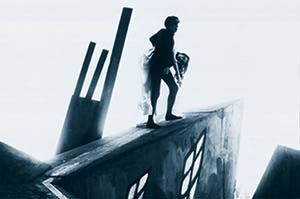 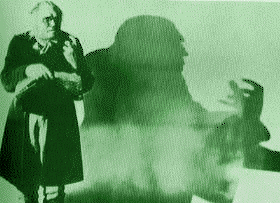 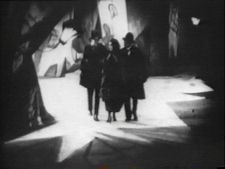 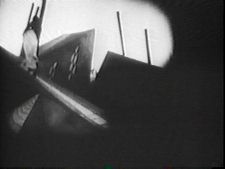
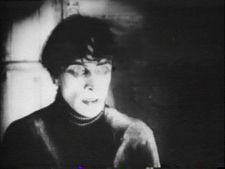 |
the film that "first brought expressionism to the German cinema
Expressionist Cinema Characteristics
Theme Horror, dark
fantasy, the Gothic. Illness, death, insanity.
Visual Style -
Mise-en-scene
Set design, lighting, costume design (props), blocking
(actor movement).
Sets express inner state of characters
Lighting
stylized to express inner states
Performance Style/Blocking--jerky
gestures express inner torment
Cinematography - Such as focus,
framing, camera movement, film stocks
Stationary camera
Long shots
(few close-ups)
Minimal editing Link
German Expressionist Art as Model for Caligari
• Drawings
brought to life (moving painting)
• Extremely stylized
•
Mise-en-scene as primary “site” of expression in German Expressionist Film
• Shapes are distorted
• Expressionism as counter to realistic
depictions of life or Romanticism in art
• Actors costumed in heavy
make-up and move in slow, jerky, sinuous patterns
• Characters as part
of visual elements of set
• Expressionist stylization conveys themes;
i.e. distortion or madness, fantasy
• Lighting – high contrast between
light and shadow
• Mise-en-scene interact to visually compose film. Link
Caligari drew on a rich heritage of expressionistic art and theater. The painted scenery, bizarre perspectives and viewpoints, the lighting of individuals to draw attention to their inner emotions were common techniques in all the arts during that period. Caligari owes much of its set design to the Romantic-Expressionistic theatrical productions of Max Reinhart. Reinhart developed many of the techniques used in the early German Cinema as "cost cutting" measures.
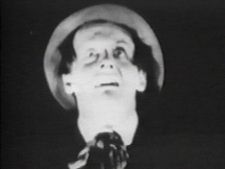
Alan is
spotlighted to focus on his inner turmoil, the friends meet on a street
with painted shadows and an unreal perspective, Alan's death is proceeded
by an eerie shadow creeping toward him, the creeping shadow effect was
later used to perfection in Nosferatu
LINK TO STORY OF FILM WITH PHOTOS Here
WEB VIDEO CLIP AVAILABLE AT
http://thesync.com/features/
 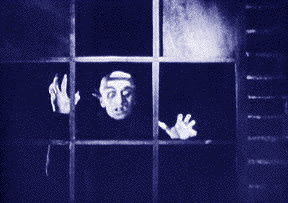   |
The original Nosferatu: A Symphony of Horrors premiered at the Marble Gardens in the Berlin Zoological Gardens, March 1922. A Prana-Films production, this thinly veiled adaptaion of Bram Stoker's classic novel Dracula was directed by F.W.Murnau and starred Max Shreck in the starring role as the undead "Graf Orlock".
Murnau made his Dracula as hideous, doomed, and gloomy as later incarnations are suave, elegant, and tasteful. His heightened sets and shadowy exteriors mirror the moods of the film's human subjects....Murnau, a pioneering member of the German Expressionist movement creates a dreamlike world that draws its strength from the real world. Unlike his contemporaries, Murnau took his camera to locations depicted in the story. He then transforms those locations into expressions of his characters.
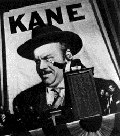 'Citizen
Kane' was made in 1941 and is considered to be one of the best films ever
made. It introduced new lighting techniques, new camera techniques, and
the wide angle lens. A new genre was also introduced this decade called
film noir, which is French for "black film".
'Citizen
Kane' was made in 1941 and is considered to be one of the best films ever
made. It introduced new lighting techniques, new camera techniques, and
the wide angle lens. A new genre was also introduced this decade called
film noir, which is French for "black film".
 Lightprop (1925 )
- a still from his kinetic structure Light Space Modulator Sculptor and
also filmed in his film Light Prop Black White Grey
Lightprop (1925 )
- a still from his kinetic structure Light Space Modulator Sculptor and
also filmed in his film Light Prop Black White Grey
Click for
link to larger image at site or local link here
Photography that manipulates and plays with light. Light compositions.
 WEB VIDEO
CLIP OF Light-Space Modulator
WEB VIDEO
CLIP OF Light-Space Modulator
http://www.atsweb.neu.edu/bostonmodernism/bauhaus2.html
Light-Space Modulator 1923-30 (rebuilt 1970)
 Classic of Bauhaus style. A kinetic sculpture
Classic of Bauhaus style. A kinetic sculpture
The Licht Raum Modulator of Moholy-Nagy is one of the most spectacluar three dimensional works of art of the twenties. The first version of this machine was made by the artist himself and formed part of many important exhibitions in the twenties and thirties. Moholy-Nagy saw this 'kinetic' (moving) piece of plastic art in the first place as a stage play. He used the machine also as an aid in a movie 'Schwarz-Weiss-Grau', 1930 Moreover he saw the machine as an autonomous sculpture, as a construction of which the motion and reflection of the material cause a light play in space. Moholy-Nagy tried to give art a real, concrete function with this work, starting from the idea that machines, besides their functionality, have a certain beauty, aestheticism too.
Light-Space Modulator
- made between 1922-1930 with aid of
an expert mechanic
- five feet high, aluminum and chrome-plated
surfaces driven an electric motor and chain belts
- made a film from
it "Light Play: Black and White and Grey"
- cityscape at night is a
kinetic light sculpture
- emphasis on form through light
KEYWORDS
Freedom, Space, Light, Non-representational
patterning, Photography is manipulation of light, worm and birds eye view,
light effects mysyteries, painting with light, the concerns and techniques
of making and exploring space through the use of light, shadow, motion,
color and transparency.
Bauhaus Style - emphasis on clarity and geometric design, manipulation and analysis of form, exploring light, texture and colour
1923 - 28 taught at Bauhaus, member of revolutionary art group, Ma (Tomorrow). He practised film-making, typography and photography
Photography
Photograms - camera-less photography -
photo-sensitive emulsion. Photosculptures
Film
Ein Lichtspiel: Schwarz/Weiss/Grau (Light Play:
Black/White/Grey) 1922 - 30
ABC of Sound
UNCOMPLETED FILM
- Dyanamic of Metropolis (conceptualised as a purley visual
experience that would bring the viewer actively into the dynamics of the
city [Would have been interesting]
Books articles
Painting, Photography. Motion Pictures
1925 -"The essence of the reflected light play is the production of
light-space-time tensions in color or chiaroscuro harmonies by kinetic
means, in a continuity of motion." Laszlo Moholy-Nagy, Painting,
Photography, Film, 1925
Vision in Motion (1947)
BOOK: A New Instrument of Vision (1932)
Laszlo Moholy-Nagy’s photogram pictures employed a moving light source as a creative agent to record images of nature (Moholy-Nagy 1969). In the early 1920's, Laszlo Moholy-Nagy developed a technique called the photogram or camera-less photograph (independent of Man Ray), to record the temporal movements of light. He employed a moving light source as a creative agent to capture images of nature (Moholy-Nagy 1969). This technique was derived from a rational attempt to paint the penetration of lights through planes. The black, white and gray values of the photograms revealed the spatial quality constructed by traces of light. Moholy-Nagy used these "light-compositions" or "light-phenomena" to help us see the world with a new vision. His Light-Space-Modulator was a kinetic sculpture that produced a "light chronology" with rotating metal and glass parts. Moholy-Nagy considered his film of this light machine (Light Display Black-White-Gray) more important than the device itself because it revealed unexpected motions, reflections, projections, and rhythms of light and shadow (Moholy-Nagy 1969). Moholy-Nagy's optical synthesis, through the production of photograms and the light display film, documents space with superimpositions of objects and the interplay between light and shadows. Link
Text from Moholy-Nagy's
A New Instrument of Vision (1932)
THE LIGHT VARIETIES OF PHOTOGRAPHIC VISION
- Abstract seeing by means of direct records of forms produced by light: the photogram which captures the most delicate gradations of light values, both chiaroscuro and coloured.
- Exact seeing by means of the normal fixation of the appearance of things: reportage.
- Rapid seeing by means of the fixation of movements in the shortest possible time: snapshots.
- Slow seeing by means of the fixation of movements spread over a period of time: e.g., the luminous tracks made by the headlights of motor cars passing along a road at night: prolonged time exposures.
- Intensified seeing by means of a) micro-photography; b) filter-photography, which, by variation of the chemical composition of the sensitised surface, permits photographic potentialities to be augmented ill various ways-ranging from the revelation of far-distant landscapes veiled in haze or fog to exposures in complete darkness: infra-red photography.
- Penetrative seeing by means of X-rays: radiography.
- Simultaneous seeing by means of transparent superimposition: the future process of automatic photomontage.
- Distorted seeing: optical jokes that can be automatically produced by: a) exposure through a lens fitted with prisms, and the device of reflecting mirrors; or b) mechanical and chemical manipulation of the negative after exposure. . . . All interpretations of photography have hitherto been influenced by the aesthetic-philosophic concepts that circumscribed painting. These were for long held to be equally applicable to photographic practice. Up to now, photography has remained in rather rigid dependence on the traditional forms of painting; and like painting it has passed through the successive stages of all the various 'isms'; though ill no sense to its advantage. Fundamentally new discoveries cannot for long be confined to the mentality and practice of bygone periods with impunity. When that happens all productive activity is arrested. This was plainly evinced in photography, which has yielded no results of any value except in those fields where, as in scientific work, it has been employed without artistic ambitions. Here alone did it prove the pioneer of an original development, or of one peculiar to itself.
ABC of Sound
Link
Hungarian
Laszlo Moholy-Nagy, who was also involved in the Bauhaus, continued
Fischingers experiments with direct (hand drawn) manipulation of the
optical sound track. In 1933 he made his film ABC of Sound which he
described as a lighthearted experiment. In that film, the soundtrack was
rephotographed for simultaneous projection onto the screen. Moholy-Nagys
ABC of Sound was shown in London in 1934 at the Film Society where Norman
McLaren was able to see it. Later, after McLaren had moved to the USA in
1939, he made a film called Allegro, one of his first experiments in
drawing both the image and sound track on film.
Extract from Article
Experimental/Abstract Film and Synaesthetic
Phenomena 1725 - 1970
http://myweb.lmu.edu/mmilicevic/pers/exp-film.html
Shadow effects for the opera "Madam Butterfly," State Opera, Berlin, 1931
 Click for link to larger image at site
Click for link to larger image at site
MORE IMAGES - thumbnails and larger images, great resource 



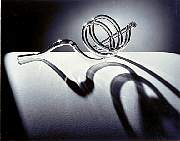
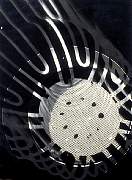
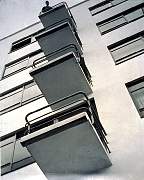

http://www.geh.org/fm/amico99/htmlsrc2/moholy_sld00004.html#81:2163:0065
http://www.geh.org/fm/amico99/htmlsrc2/index.html
http://www.geh.org/fm/amico99/htmlsrc2/moholy_idx00001.html#98:0883:0001
 Bill Brandt was born to a prosperous mercantile family in
Hamburg in 1904. In the psychologically haunting and formally inventive
portraits and nudes of the next fifteen years, the photographer explored
his private fantasies through the distorting lens of a wide-angle camera.
The compressed space in "Nude, Campden Hill, London," for instance,
suggests both the incongruous scale inversions and claustrophobic
Victorian atmosphere of "Alice in Wonderland," one of Brandt's favorite
books, and the hallucinatory, kinesthetic exaggerations of the
Surrealists.
Bill Brandt was born to a prosperous mercantile family in
Hamburg in 1904. In the psychologically haunting and formally inventive
portraits and nudes of the next fifteen years, the photographer explored
his private fantasies through the distorting lens of a wide-angle camera.
The compressed space in "Nude, Campden Hill, London," for instance,
suggests both the incongruous scale inversions and claustrophobic
Victorian atmosphere of "Alice in Wonderland," one of Brandt's favorite
books, and the hallucinatory, kinesthetic exaggerations of the
Surrealists.
This technique employs fast falloff, and, strong contrast between light
and dark. The use chiaroscuro defines the three-dimensional aspects of the
photo. It gives depth and clarity to both the fore and background. The
large area of black between the nude and the bedroom scene is a perfect
example of the contrast between light and dark separating the foreground
from the background.
Maya Deren
WEB VIDEO CLIP AVAILABLE AT:
http://www.re-voir.com/html/derenprojection.html
Stark Lighting
Film as personal story - advent of 16 mm equipment
Some of the most startling images in Maya Deren's film-poem, "Meshes of the Afternoon," were coopted in 1994 by model-turned-actress-turned-songstress Milla Jovovich for a music video, which says even more about Deren's durable work than the dearth of new ideas on MTV. Working in the 1940s and 50s, Deren was the first giant of American experimental filmmaking. Her short films anticipated the work of Stan Brakhage, Jonas Mekas, and other pioneers even as her life, tinged with mystery, sadness, and Voudoun ritual (read Voodoo if you like), became the stuff of legend among the artists she influenced. The movies themselves (some made in collaboration with husband Alexander "Sasha" Hammid) are haunting, lyrical, and breathtaking fusions of human and cinematic movement, where the actors dance with the camera. Lillian Gish and Leni Riefenstahl are perhaps the only women who stand as tall as Deren in the development of the cinema.
Stan Brakhage
The use of lighting and shadows along with his unique camera angles and
dynamic movements complement the feeling of shared sights from an inward
perspective.
Pure art form of film, moving away from stories and content and turned to a graphical abstract approach freeing film from dramatic elements and also from photographic documentary aspects. Film defined as rhythmic patterns of colour and forms as paintings in time
Surrealist movement
Federico fellini, Pier Paolo Pasolini,
Jean Cocteau, Carlos Saura, Bernardo Bertolucci
Bleeps
Lighting --
A Basic Definition / Primary Visual Styles
A basic definition of lighting.
Four crucial considerations in lighting.
The basic functions of lighting.
Styles of lighting -- low vs. high key (chiaroscuro vs. flat lighting) — Rembrandt, cameo, silhouette.
Lighting Techniques
Introduction to basic lighting tools & techniques.
Basic three point lighting techniques.
Lighting for mood and information
Time and Motion Primary, secondary, and tertiary motion. Time in the edit -- story time, running time, subjective time and edit rhythms. Color Color functions and use in composition. Psychological and cultural effects of color. Color symbolism, energy, and expression.
INTERESTING LINKS
Observe the light sensitivity of silver when exposed to iodine crystals. WEB MOVIE CLIP link
An optical viewing device called a camera lucida superimposed a scene onto the artist's drawing surface. link